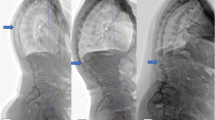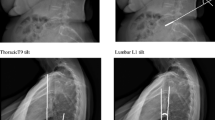Abstract
Summary
We compared global sagittal alignment and quality of life in osteoporotic patients with and without vertebral compression fracture (VCF) and determined its relationship with VCF severity. The findings revealed osteoporotic patients with VCF showed decreased quality of life and worse global sagittal alignment, which was significantly associated with VCF severity.
Introduction
The aim of this study was to compare the global sagittal alignment and quality of life in elderly osteoporotic patients with and without vertebral compression fracture (VCF), and to investigate the relationship between global sagittal alignment and severity of VCF.
Methods
A consecutive series of 72 female patients with osteoporosis aged over 60 years and 31 age-matched females without osteoporosis were prospectively enrolled. The patients were divided into VCF and non-VCF group. Patient’s clinical demography, nature of VCF, and bone mineral density (BMD) were also recorded. Spinal deformity index was used to evaluate severity of VCF. EOS® biplanar imaging system was then used to evaluate global sagittal parameters: T1 pelvic angle (TPA) and global sagittal angle (GSA). In addition, quality of life was assessed with self-reported questionnaires: the Oswestry Disability Index (ODI) and Short-form 12 (SF-12).
Results
Osteoporotic patients and controls were found to be significantly different in terms of TPA, GSA, and BMD. And in patients with VCF, they were found to have significantly higher TPA and GSA. TPA and GSA were significantly correlated with SF-12 and ODI. The number of VCF and SDI significantly correlated with global sagittal alignment. Using regression analysis, parameters significantly associated with abnormal global alignment were the number of VCF (OR = 1.13) and SDI (OR = 1.84).
Conclusion
Osteoporotic patients with VCF showed worse global sagittal alignment and decreased quality of life. The number and severity of VCF had a negative influence on global sagittal balance, which indicates that poorer sagittal global alignment may imply worse quality of life and more severe VCF.


Similar content being viewed by others
References
Jackson S, Tenenhouse A, Robertson L, Group CS (2000) Vertebral fracture definition from population-based data: preliminary results from the Canadian multicenter osteoporosis study (CaMos). Osteoporos Int 11(8):680–687
Ferrar L, Roux C, Felsenberg D, Glüer C, Eastell R (2012) Association between incident and baseline vertebral fractures in European women: vertebral fracture assessment in the osteoporosis and ultrasound study (OPUS). Osteoporos Int 23(1):59–65
Ettinger B, Black DM, Nevitt MC, Rundle AC, Cauley JA, Cummings SR, Genant HK (1992) Contribution of vertebral deformities to chronic back pain and disability. J Bone Miner Res 7(4):449–456
Bliuc D, Nguyen ND, Milch VE, Nguyen TV, Eisman JA (2009) Mortality risk associated with low-trauma osteoporotic fracture and subsequent fracture in men and women. JAMA 301(5):513–521
Gabriel SE, Tosteson AN, Leibson CL, Crowson CS, Pond GR, Hammond CS, Melton L III (2002) Direct medical costs attributable to osteoporotic fractures. Osteoporos Int 13(4):323–330
Pluijm S, Tromp A, Smit J, Deeg D, Lips P (2000) Consequences of vertebral deformities in older men and women. J Bone Miner Res 15(8):1564–1572
Norimatsu H, Mori S, Uesato T, Yoshikawa T, Katsuyama N (1989) Bone mineral density of the spine and proximal femur in normal and osteoporotic subjects in Japan. Bone Miner 5(2):213–222
Snyder B, Piazza S, Edwards W, Hayes W (1993) Role of trabecular morphology in the etiology of age-related vertebral fractures. Calcif Tissue Int 53(1):S14–S22
Vokes T, Giger M, Chinander M, Karrison T, Favus M, Dixon L (2006) Radiographic texture analysis of densitometer-generated calcaneus images differentiates postmenopausal women with and without fractures. Osteoporos Int 17(10):1472–1482
Lee JS, Lee HS, Shin JK, Goh TS, Son SM (2013) Prediction of sagittal balance in patients with osteoporosis using spinopelvic parameters. Eur Spine J 22(5):1053–1058
Lam CL, Eileen Y, Gandek B (2005) Is the standard SF-12 health survey valid and equivalent for a Chinese population? Qual Life Res 14(2):539–547
Chow JH, Chan CC (2005) Validation of the Chinese version of the Oswestry Disability Index. Work 25(4):307–314
Zhu TY, Griffith JF, Qin L, Hung VW, Fong T-N, Kwok AW, Leung P-C, Li EK, Tam L-S (2012) Bone density and microarchitecture: relationship between hand, peripheral, and axial skeletal sites assessed by HR-pQCT and DXA in rheumatoid arthritis. Calcif Tissue Int 91(5):343–355
Deschênes S, Charron G, Beaudoin G, Labelle H, Dubois J, Miron M-C, Parent S (2010) Diagnostic imaging of spinal deformities: reducing patients radiation dose with a new slot-scanning X-ray imager. Spine 35(9):989–994
Fechtenbaum J, Etcheto A, Kolta S, Feydy A, Roux C, Briot K (2016) Sagittal balance of the spine in patients with osteoporotic vertebral fractures. Osteoporos Int 27(2):559–567
Genant HK, Wu CY, van Kuijk C, Nevitt MC (1993) Vertebral fracture assessment using a semiquantitative technique. J Bone Miner Res 8(9):1137–1148
Kerkeni S, Kolta S, Fechtenbaum J, Roux C (2009) Spinal deformity index (SDI) is a good predictor of incident vertebral fractures. Osteoporos Int 20(9):1547–1552
Roux C, Fechtenbaum J, Kolta S, Said-Nahal R, Briot K, Benhamou CL (2010) Prospective assessment of thoracic kyphosis in postmenopausal women with osteoporosis. J Bone Miner Res 25(2):362–368
Dai J, Yu X, Huang S, Fan L, Zhu G, Sun H, Tang X (2015) Relationship between sagittal spinal alignment and the incidence of vertebral fracture in menopausal women with osteoporosis: a multicenter longitudinal follow-up study. Eur Spine J 24(4):737–743
Roussouly P, Pinheiro-Franco JL (2011) Sagittal parameters of the spine: biomechanical approach. Eur Spine J 20(5):578–585
Barrey C, Roussouly P, Le Huec J-C, D’Acunzi G, Perrin G (2013) Compensatory mechanisms contributing to keep the sagittal balance of the spine. Eur Spine J 22(6):834–841
Diebo BG, Ferrero E, Lafage R, Challier V, Liabaud B, Liu S, Vital J-M, Errico TJ, Schwab FJ, Lafage V (2015) Recruitment of compensatory mechanisms in sagittal spinal malalignment is age and regional deformity dependent: a full-standing axis analysis of key radiographical parameters. Spine 40(9):642–649
Roussouly P, Nnadi C (2010) Sagittal plane deformity: an overview of interpretation and management. Eur Spine J 19(11):1824–1836
Ferrero E, Liabaud B, Challier V, Lafage R, Diebo BG, Vira S, Liu S, Vital JM, Ilharreborde B, Protopsaltis TS (2016) Role of pelvic translation and lower-extremity compensation to maintain gravity line position in spinal deformity. J Neurosurg Spine 24(3):436–446
Ramchandran S, Smith JS, Ailon T, Klineberg E, Shaffrey C, Lafage V, Schwab F, Bess S, Daniels A, Scheer JK (2015) Assessment of impact of long-cassette standing X-rays on surgical planning for cervical pathology: an international survey of spine surgeons. Neurosurgery 78(5):717–724
Roussouly P, Gollogly S, Noseda O, Berthonnaud E, Dimnet J (2006) The vertical projection of the sum of the ground reactive forces of a standing patient is not the same as the C7 plumb line: a radiographic study of the sagittal alignment of 153 asymptomatic volunteers. Spine 31(11):E320–E325
Protopsaltis T, Schwab F, Bronsard N, Smith JS, Klineberg E, Mundis G, Ryan DJ, Hostin R, Hart R, Burton D (2014) The T1 pelvic angle, a novel radiographic measure of global sagittal deformity, accounts for both spinal inclination and pelvic tilt and correlates with health-related quality of life. JBJS 96(19):1631–1640
Diebo BG, Oren JH, Challier V, Lafage R, Ferrero E, Liu S, Vira S, Spiegel MA, Harris BY, Liabaud B (2016) Global sagittal axis: a step toward full-body assessment of sagittal plane deformity in the human body. J Neurosurg Spine 25(4):494–499
Jalai CM, Cruz DL, Diebo BG, Poorman G, Lafage R, Bess S, Ramchandran S, Day LM, Vira S, Liabaud B (2017) Full-body analysis of age-adjusted alignment in adult spinal deformity patients and lower-limb compensation. Spine 42(9):653–661
Zhang Y-L, Shi L-T, Tang P-F, Sun Z-J, Wang Y-H (2017) Correlation analysis of osteoporotic vertebral compression fractures and spinal sagittal imbalance. Orthopade 46(3):249–255
Baek S-W, Kim C, Chang H (2015) The relationship between the spinopelvic balance and the incidence of adjacent vertebral fractures following percutaneous vertebroplasty. Osteoporos Int 26(5):1507–1513
Kushida K, Fukunaga M, Kishimoto H, Shiraki M, Itabashi A, Inoue T, Kaneda K, Morii H, Nawata H, Yamamoto K (2004) A comparison of incidences of vertebral fracture in Japanese patients with involutional osteoporosis treated with risedronate and etidronate: a randomized, double-masked trial. J Bone Miner Metab 22(5):469–478
Wilson S, Sharp C, Davie M (2012) Health-related quality of life in patients with osteoporosis in the absence of vertebral fracture: a systematic review. Osteoporos Int 23(12):2749–2768
Al-Sari U, Tobias J, Clark E (2016) Health-related quality of life in older people with osteoporotic vertebral fractures: a systematic review and meta-analysis. Osteoporos Int 27(10):2891–2900
Author information
Authors and Affiliations
Corresponding author
Ethics declarations
Conflict of interest
None.
Rights and permissions
About this article
Cite this article
Hu, Z., Man, G.C.W., Kwok, A.K.L. et al. Global sagittal alignment in elderly patients with osteoporosis and its relationship with severity of vertebral fracture and quality of life. Arch Osteoporos 13, 95 (2018). https://doi.org/10.1007/s11657-018-0512-y
Received:
Accepted:
Published:
DOI: https://doi.org/10.1007/s11657-018-0512-y




